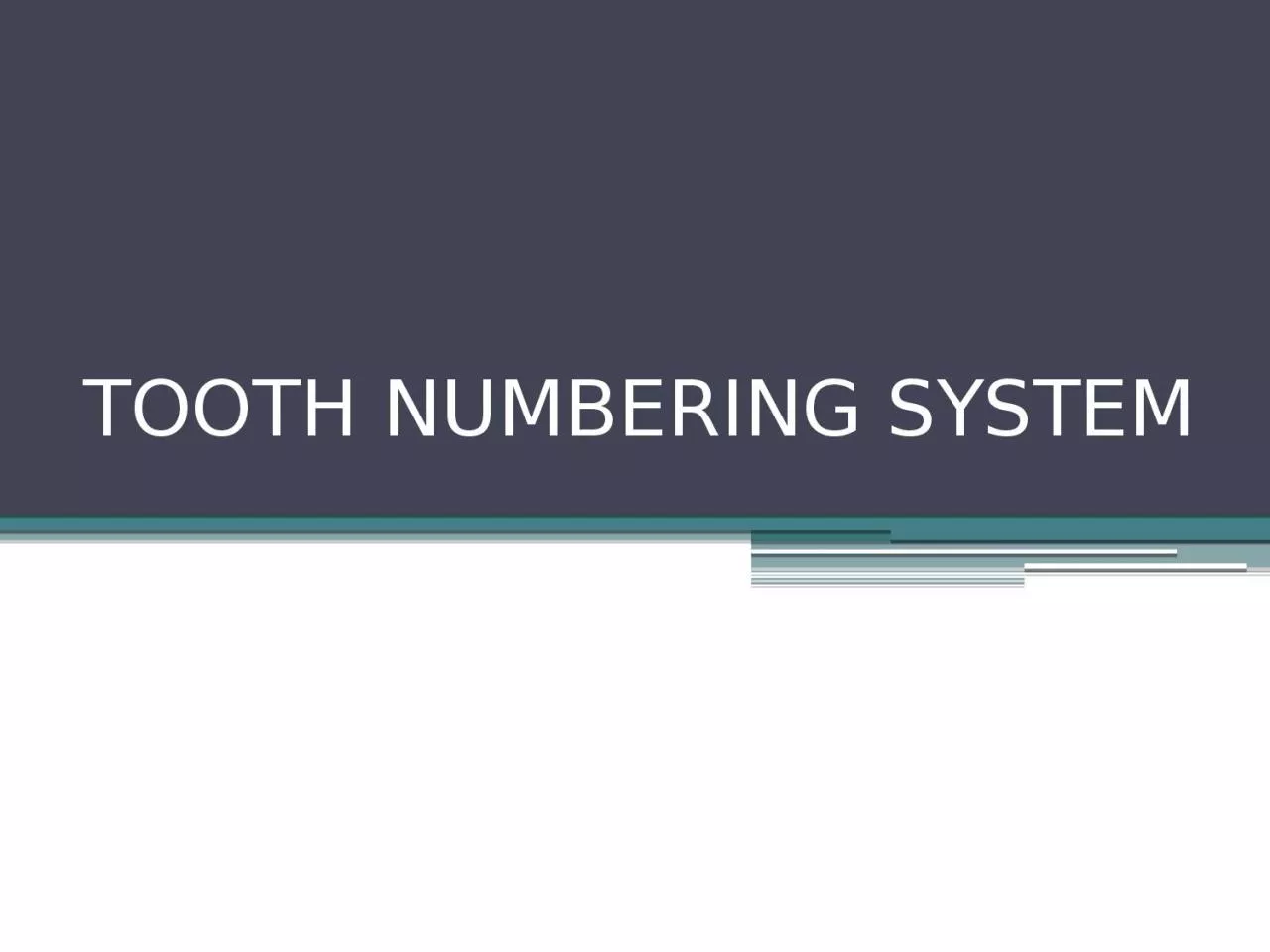

There are several systems in world 3 main systems are Universal Notation System ZsigmondyPalmer Notation System Federation Dentaire Internationale FDI PRIMARY DENTITION Dental formula for the deciduous teeth ID: 1012254
Download Presentation The PPT/PDF document "TOOTH NUMBERING SYSTEM Types of numberin..." is the property of its rightful owner. Permission is granted to download and print the materials on this web site for personal, non-commercial use only, and to display it on your personal computer provided you do not modify the materials and that you retain all copyright notices contained in the materials. By downloading content from our website, you accept the terms of this agreement.
1. TOOTH NUMBERING SYSTEM
2. Types of numbering system’s. There are several systems in world, 3 main systems are :Universal Notation System.Zsigmondy/Palmer Notation System.Federation Dentaire Internationale (FDI).
3. PRIMARY DENTITIONDental formula for the deciduous teeth
4. PERMANENT DENTITIONDental formula for the permanent human dentition is as follows
5. Universal Notation SystemThe universal system of notation for the primary dentition uses ‘uppercase letters’ for each of the primary teeth.For the maxillary teeth, beginning with the right second molar, letters A through J, and for the mandibular teeth, letters K through T, beginning with the left mandibular second molar.The ADA in 1968 officially recommended the “universal” numbering system.2) For the permanent teeth ;1)For the primary teeth ;
6. Universal Notation SystemThe universal system of notation for the permanent dentition uses ‘numbers’ for each of the permanent teeth.The maxillary teeth are numbered from 1 through 16, beginning with the right third molar. Beginning with the mandibular left third molar, the teeth are numbered 17 through 32.
7. Zsigmondy/Palmer Notation System.Symbolic systemIn this system the arches are divided into quadrants. - upper right - upper left - lower right - lower leftThe Palmer notation for the entire deciduous dentition is as follows:
8. Zsigmondy/Palmer Notation System.For the permanent dentition is a four-quadrant symbolic system.Beginning with the central incisors, the teeth are numbered 1 through 8 (or more) in each arch. - upper right - upper left - lower right - lower left
9. Federation Dentaire Internationale (FDI).Two-digit system.Proposed by FDI has been Adopted by the WHO and by other organizations such as the International Association for Dental Research.The first digit indicates the quadrant: 5 to 8 for the primary dentition.The second digit indicates the tooth within a quadrant 1 to 5 for the primary teeth.
10. Federation Dentaire Internationale (FDI).The first digit indicates the quadrant: 1 to 4 for the permanent dentition.The second digit indicates the tooth within a quadrant:1 to 8 for the permanent teeth.For example, the permanent upper right central incisor is 11 (pronounced “one one,” not “eleven”).
11.
12. Ideal properties of an index:Clarity: The examiner should be able to carry out the index rules in his mind.Simplicity: The index should be easily to apply.Objectivity: The index criteria should have clear-cut.Validity: The index should be measure what it is intended to measure. So it should be correspond with clinical stages of the disease, (ex. number of missing teeth in adults is not a valid measure of caries activity ?).
13. Ideal properties of an index:Reliability: The index should measure consistently at different times and under a variety of conditions, by the same person or different persons.Quantifiability: The index should have meaning to statistical analysis. So that the status of a group can be expressed by a number that corresponds to a relative position on a scale from zero to the upper limit.Sensitivity: The index should be able to detect reasonably small shifts, in either direction in the group condition.Acceptability: The use of the index should not be painful or demeaning to the subject.
14. Uses of dental indices:1. To provide data for epidemiological studies by studying prevalence, incidence, and severity of disease. 2. To study and compare oral health status of individuals and population and finding out etiological and predisposing factors for the diseases.3. For planning of oral health policy and evaluating the success and effectiveness of preventive programs.
15. Classification of indices:Depending on the direction in which their scores can fluctuate:Depending on the extent to which areas of oral cavity are measured:Depending on the entity which they measured for:
16. Indices used for dental caries assessmentIndices used for coronal caries. A- Permanent teeth. B- Primary teeth.Indices used for root caries.
17. -Permanent teeth index:(Decayed-Missing-Filled)Index (DMF) which was introduced by Klein, Palmer and Knutson in 1938 and modified by WHO:1-DMF teeth index (DMFT) which measures the prevalence of dental caries/Teeth.2- DMF surfaces index (DMFS) which measures the severity of dental caries.
18. Calculation of DMFT \ DMFS: Minimum score = ZeroMaximum score: 1- DMFT = 32DMFS = 12 * 4 + 20 * 5 = 48 + 100 = 148 or 128
19. *Root Caries Index (RCI), which was introduced by Katz in 1979:RCI is based on the requirement that gingival recession must occur before root surface lesions begin. Therefore, only teeth with gingival recession are examined.1. All teeth are examined in both the lower and upper arch.2. To obtain the RCI, each of the four surfaces the mesial, distal, buccal (labial), and lingual, of a root are examined for a single tooth.3. When multiple types of root surfaces are exposed, the most severely affected root surface be recorded for that tooth.